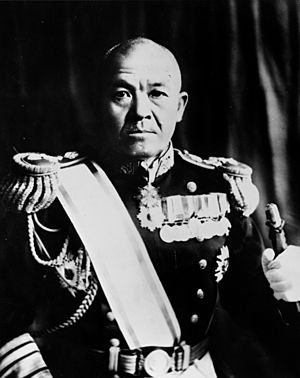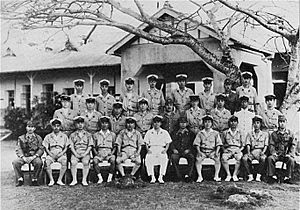Chūichi Nagumo facts for kids
Quick facts for kids
Chūichi Nagumo
|
|
|---|---|

Vice Admiral Nagumo Chūichi
|
|
| Native name |
南雲 忠一
|
| Born | 25 March 1887 Yonezawa, Yamagata, Empire of Japan |
| Died | 6 July 1944 (aged 57) Saipan, South Seas Mandate |
| Allegiance | |
| Service/ |
|
| Years of service | 1908–1944 |
| Rank | |
| Commands held | Kisaragi, Momi, Saga, Uji, Naka, 11th Destroyer Division, Takao, Yamashiro, 1st Destroyer Squadron, 8th Squadron, Naval Torpedo School, 3rd Squadron, Naval War College, 1st Air Fleet, 1st Carrier Division, 3rd Fleet, Sasebo Naval District, Kure Naval District, 1st Fleet, Central Pacific Area Fleet, 14th Air Fleet |
| Battles/wars | World War II
|
| Awards | Order of the Rising Sun (3rd class) Order of the Rising Sun (4th class) Order of the Golden Kite (3rd class) Grand Cordon of the Order of the Sacred Treasure (1st class) |
Chūichi Nagumo (南雲 忠一, Nagumo Chūichi; born March 25, 1887 – died July 6, 1944) was an important admiral in the Imperial Japanese Navy during World War II. He was famous for leading Japan's main group of aircraft carriers, called the Kido Butai. This group was involved in major attacks like the attack on Pearl Harbor and the Battle of Midway. Admiral Nagumo died during the Battle of Saipan.
Contents
Chūichi Nagumo was born in Yonezawa, Japan, in 1887. He joined the Navy Academy in 1908. He was a good student, finishing 8th in his class.
Nagumo learned a lot about torpedoes and how to use them in naval battles. He also became skilled in destroyer tactics. He slowly moved up the ranks, becoming a lieutenant commander in 1920.
From 1925 to 1926, Nagumo traveled to Europe and the United States. He studied how other navies fought and what equipment they used. When he returned to Japan, he served in China. He commanded several ships, including the gunboats Saga and Uji.
He became a captain in 1929 and later a Rear Admiral in 1935. As a Rear Admiral, he helped the Japanese Army in China. He also taught at the Torpedo School and the Naval War College. By 1939, he was promoted to Vice Admiral.
World War II and Key Battles
In April 1941, Nagumo was put in charge of the First Air Fleet. This was the main group of aircraft carriers for the Japanese Navy. Some people wondered if he was the right choice because he didn't have much experience with naval aviation.
Even though he was getting older and had some health issues like arthritis, he was a careful planner. He thought through every battle plan very carefully.
Admiral Nishizo Tsukahara felt that Nagumo was from the "old school" of naval officers. He specialized in torpedoes and surface ship battles, not air power. However, Nagumo's younger officers saw him as a father figure.
Nagumo was a strong believer in using both ships and aircraft together. But he disagreed with Admiral Isoroku Yamamoto's plan to attack the United States Navy base at Naval Station Pearl Harbor.
Attack on Pearl Harbor
Despite his doubts, Nagumo led the attack on Pearl Harbor. This surprise attack in December 1941 was a big success for Japan. However, Nagumo was later criticized for not launching a third attack. This third attack might have destroyed important fuel and repair facilities at Pearl Harbor. If those had been destroyed, it would have made the base useless for a long time.
Early Victories
Nagumo had many successes in early 1942. He led the fleet in the Bombing of Darwin in Australia. He also led the Indian Ocean raid, where his forces sank an aircraft carrier, two cruisers, and two destroyers. This forced the British fleet to retreat.
Battle of Midway
Nagumo's winning streak ended at the Battle of Midway in June 1942. During the battle, a damaged American bomber almost crashed into Nagumo's flagship, the aircraft carrier Akagi. This near-miss might have made Nagumo even more determined to attack the American forces.
He faced a difficult situation. His planes were armed for attacking land targets, but then he got reports of American ships nearby. He had to quickly re-arm his planes with torpedoes to attack ships. This took valuable time.
During the battle, the Akagi was hit by bombs. Nagumo was shaken by the explosions and the loss of his carriers. He seemed to go into shock. Witnesses saw him staring at the flames on his ship. He didn't want to leave the Akagi, saying, "It's not time yet." His chief of staff, Rear Admiral Ryūnosuke Kusaka, finally convinced him to leave. Nagumo and his staff had to escape by rope from the ship's bridge.
Japan lost four aircraft carriers at Midway. This was a major turning point in the war. Japan also lost many experienced pilots and maintenance crews. This made it harder for them to fight in later battles. After this defeat, Nagumo seemed to lose his fighting spirit. He never fully recovered from the loss of his carriers.
Later Operations and Death
After Midway, Nagumo was put in charge of the Third Fleet. He commanded aircraft carriers in the Guadalcanal campaign, including the battles of the Eastern Solomons and the Santa Cruz Islands. His actions in these battles were not very decisive, and Japan continued to lose naval strength.
In November 1942, Nagumo was sent back to Japan. He was given command of naval districts, mostly involved in training duties.
As Japan's situation in the war got worse, Nagumo was sent to the Mariana Islands in March 1944. He was put in charge of the Central Pacific Area Fleet.
The Battle of Saipan began on June 15, 1944. The Japanese Navy was quickly defeated by the U.S. 5th Fleet. Japan lost three aircraft carriers and about 600 aircraft. Nagumo and Army Lieutenant General Yoshitsugu Saito were left to defend Saipan on their own.
Nagumo died on July 6, 1944, during the battle. His body was found by U.S. Marines in a cave where he had spent his last days. He was promoted to Admiral after his death.
Nagumo's grave is in Kamakura, Japan, next to his son's grave. His son, Susumu Nagumo, was also killed in battle in 1944.
| IJN Insignia | Rank | Date |
|---|---|---|
 |
海軍少尉候補生 Kaigun Shōi Kōhōsei (Midshipman) |
21 November 1908 |
 |
海軍少尉 Kaigun Shōi (Ensign) |
15 January 1910 |
 |
海軍中尉 Kaigun Chūi (Sub-Lieutenant/Lieutenant Junior Grade) |
1 December 1911 |
 |
海軍大尉 Kaigun Daii (Lieutenant) |
1 December 1914 |
 |
海軍少佐 Kaigun Shōsa (Lieutenant-Commander) |
1 December 1920 |
 |
海軍中佐 Kaigun Chūsa (Commander) |
1 December 1924 |
 |
海軍大佐 Kaigun Daisa (Captain) |
30 November 1929 |
 |
海軍少将 Kaigun Shōshō (Rear-Admiral) |
15 November 1935 |
 |
海軍中将 Kaigun Chūjō (Vice-Admiral) |
15 November 1939 |
 |
海軍大将 Kaigun Taishō (Admiral) |
8 July 1944 (Posthumous) |
Nagumo in Movies and Games
Chūichi Nagumo has been shown in several movies and video games:
- In the 1970 film Tora! Tora! Tora!, he was played by Japanese actor Eijirō Tōno.
- In the 1976 film Midway, he was played by American actor James Shigeta.
- In the 2011 film Isoroku, he was played by Japanese actor Takeo Nakahara.
- In the 2019 film Midway, he was played by Japanese actor Jun Kunimura.
- In the 2004 video game Axis and Allies, Nagumo is one of the Japanese commanders you can play as.
Images for kids
-
Nagumo (left) with his friend Ichiro Saeki in Seattle, Washington in 1925
See also
 In Spanish: Chūichi Nagumo para niños
In Spanish: Chūichi Nagumo para niños




